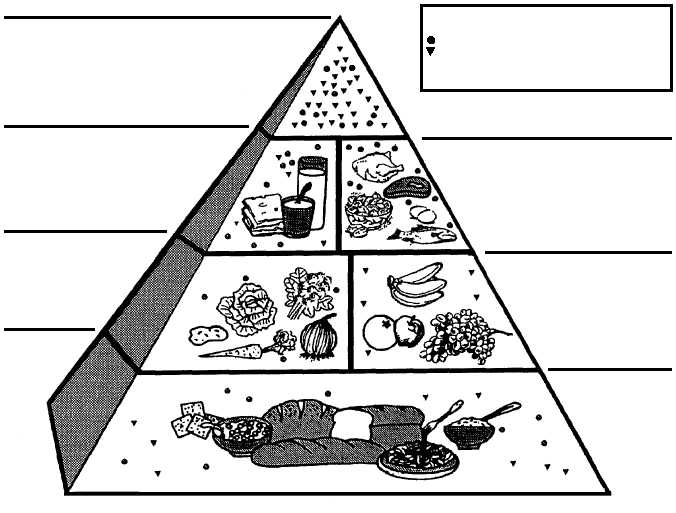GUIDE TO GOOD EATING
LEARNING OBJECTIVE:
Recall the
elements of the USDA Food Guide Pyramid
and recommended dietary guidelines.
Calculating a therapeutic diet can be complicated
and is best left to dietitians. It is now common practice
for dietitians or dietary kitchens to select foods for
diets using the food groups outlined in figure 9–2, the
Food Guide Pyramid. These foods are classified
according to their nutritional value and the number of
servings that should be eaten each day.
THE FOOD GUIDE PYRAMID
The Food Guide Pyramid emphasizes foods from
the five food groups shown in the sections of the
pyramid. Each of these groups provides some, but not
all, of the nutrients we require. For good health we
need them all. For everyday living, the simplest and
most practical plan is to follow those same guidelines,
selecting from the various food groups the type and
amount of food recommended.
DIETARY GUIDELINES
The food pyramid graphically communicates the
message of the Dietary Guidelines for Americans.
Diets should be built upon a base of complex
carbohydrates and less fats. The placement of the food
groups starting at the base of the pyramid conveys the
current recommendations. These recommendations
are as follows:
Eat more grains, vegetables, and fruits
Eat moderate amounts of lean meats and dairy
foods
Use sweets, fats, and oils sparingly
9-6
FATS, OILS, & SWEETS
USE SPARINGLY
MILK, YOGURT,
& CHEESE
GROUP
2-3 SERVINGS
VEGETABLE
GROUP
3-5
SERVINGS
KEY
FAT (NATURALLY OCCURRING AND ADDED)
SUGARS (ADDED)
THESE SYMBOLS SHOW FATS, OILS,
AND ADDED SUGARS IN FOODS.
MEAT, POULTRY, FISH
DRY BEANS, EGGS
& NUTS GROUP
2-3 SERVINGS
FRUIT
GROUP
2-4 SERVINGS
BREAD, CEREAL,
RICE, PASTA
GROUP
6-11
SERVINGS
HM3f0902
Figure 9-2.—Food Guide Pyramid.

